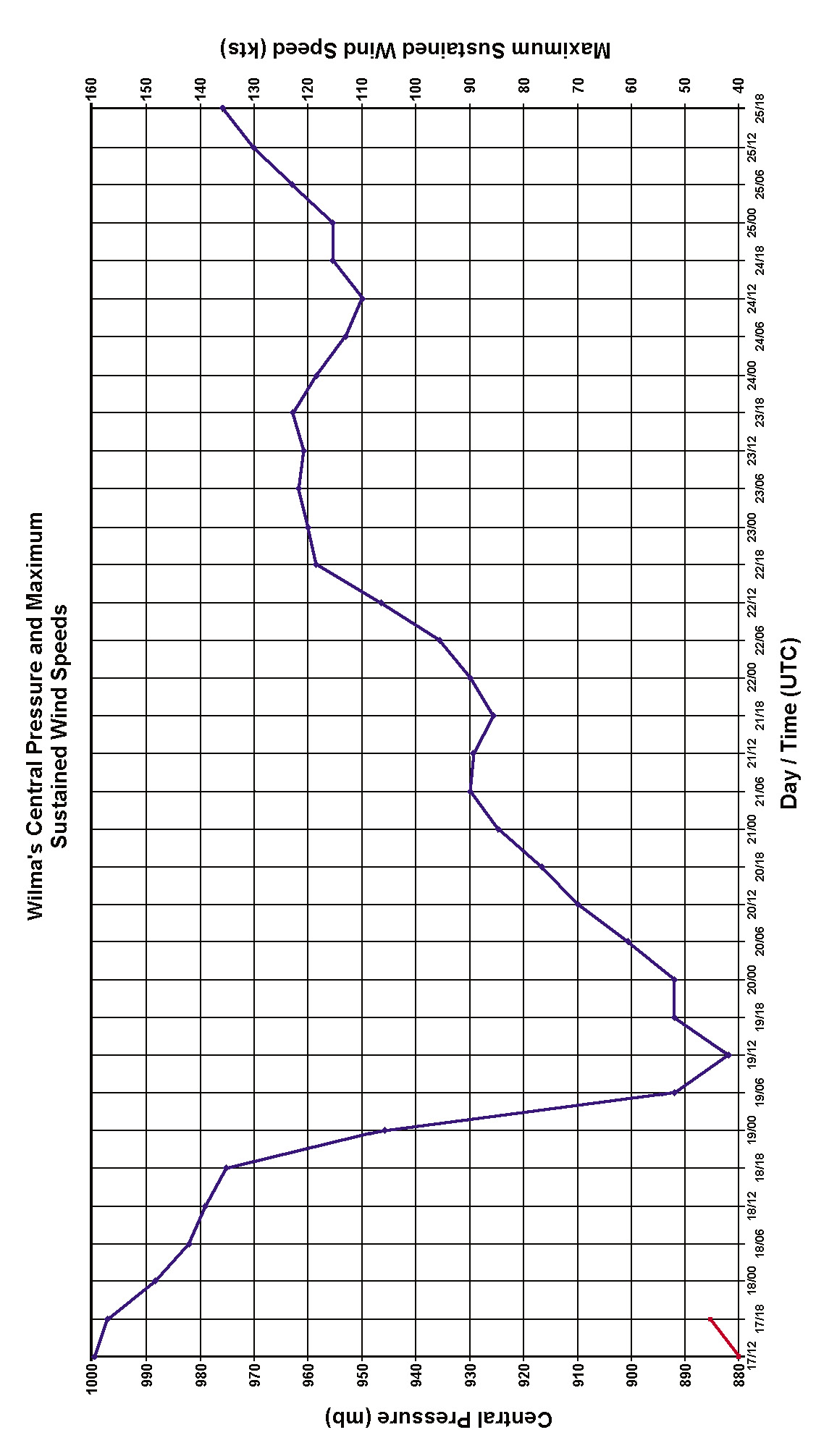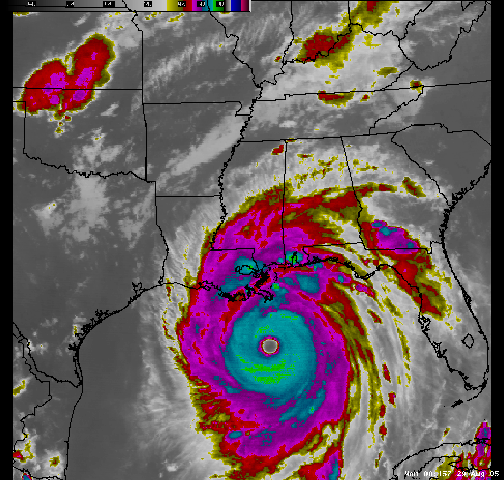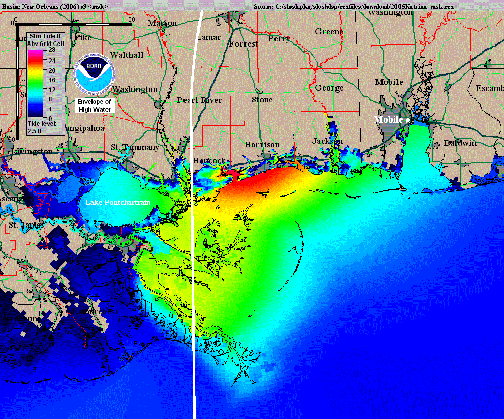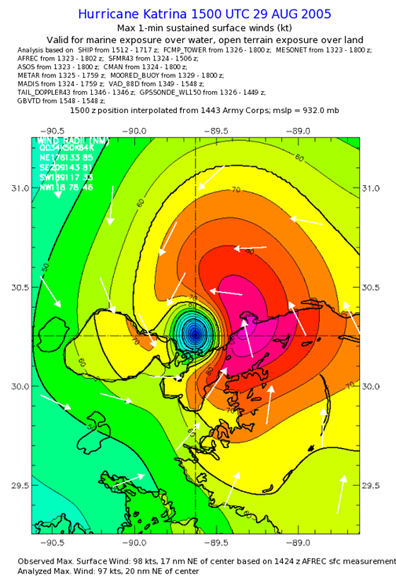HURRICANE WIND SPEEDS AND
PRESSURE CHANGES
Objectives:
Hurricanes are intense tropical cyclones spawned and sustained over warm ocean waters. They are fueled primarily by the energy transported to the atmosphere from the ocean through evaporation and subsequent condensation of water vapor within the hurricane eyewall and spiral-band cumuliform clouds. Latent heat is released as water vapor condenses, warming air that expands and rises as more humid air flows upward from near the ocean surface to replace it. Within the storm’s center or eye, air sinks and warms adiabatically. The less dense air in this warm eye exerts a lower pressure than the surrounding atmosphere, producing intense inward-directed horizontal pressure gradients that drive the air motions which result in hurricane-force winds. Low central pressures, high eyewall wind speeds, and heavy rains continue unabated until the energy supply to the hurricane is disrupted. Weakening of the system could result from travel over colder ocean waters, which reduces evaporation, or an encounter with land which limits the supply of water vapor while its surface roughness (friction) slows the winds and brings chaos to its organized structure.
After completing this investigation, you should be able to:
- Describe the relationship between the maximum wind speeds and the central pressure in a hurricane.
- Categorize the damage potential of a hurricane based on wind speeds.
- Explain how wind speeds in hurricanes are affected by landfall.
Wilma:
1. Table 1 gives, at 6-hour intervals, the position, central pressure, and maximum sustained wind speed of the tropical cyclone that evolved into Hurricane Wilma during 17 – 25 October 2005. The central pressure of the system at 00, 06, 12, and 18 UTC is graphed in Figure 1, with the pressure scale to the left. From Table 1, at what October 2005 date and time (date/UTC or Z time) was the central pressure lowest? [(19/1200)(21/1800)(24/1200)]
2. At this time the central pressure was [(950)(926)(882)] mb. This most intense condition occurred as Wilma was slowly crossing the warm waters of the Caribbean Sea east of the Yucatán Peninsula.
3. From 18/1800 to 19/1200 the total pressure fall was [(72)(93)(117)] mb.
4. This pressure fall occurred over a period of 18 hours, decreasing at the rate of about [(4.0)(5.2)(6.5)] mb/hr.
Table 1. Best track for Hurricane Wilma, 17–25 October 2005.
|
Date/time |
Lat. (ºN) |
Long. (ºW) |
Pressure (mb) |
Wind speed (kts) |
|
17/1200 |
16.3 |
79.7 |
999 |
40 |
|
17/1800 |
16.0 |
79.8 |
997 |
45 |
|
18/0000 |
15.8 |
79.9 |
988 |
55 |
|
18/0600 |
15.7 |
79.9 |
982 |
60 |
|
18/1200 |
16.2 |
80.3 |
979 |
65 |
|
18/1800 |
16.6 |
81.1 |
975 |
75 |
|
19/0000 |
16.6 |
81.8 |
946 |
130 |
|
19/0600 |
17.0 |
82.2 |
892 |
150 |
|
19/1200 |
17.3 |
82.8 |
882 |
160 |
|
19/1800 |
17.4 |
83.4 |
892 |
140 |
|
20/0000 |
17.9 |
84.0 |
892 |
135 |
|
20/0600 |
18.1 |
84.7 |
901 |
130 |
|
20/1200 |
18.3 |
85.2 |
910 |
130 |
|
20/1800 |
18.6 |
85.5 |
917 |
130 |
|
21/0000 |
19.1 |
85.8 |
924 |
130 |
|
21/0600 |
19.5 |
86.1 |
930 |
130 |
|
21/1200 |
20.1 |
86.4 |
929 |
125 |
|
21/1800 |
20.3 |
86.7 |
926 |
120 |
|
22/0000 |
20.6 |
86.8 |
930 |
120 |
|
22/0600 |
20.8 |
87.0 |
935 |
110 |
|
22/1200 |
21.0 |
87.1 |
947 |
100 |
|
22/1800 |
21.3 |
87.1 |
958 |
85 |
|
23/0000 |
21.6 |
87.0 |
960 |
85 |
|
23/0600 |
21.8 |
86.8 |
962 |
85 |
|
23/1200 |
22.4 |
86.1 |
961 |
85 |
|
23/1800 |
23.1 |
85.4 |
963 |
90 |
|
24/0000 |
24.0 |
84.3 |
958 |
95 |
|
24/0600 |
25.0 |
83.1 |
953 |
110 |
|
24/1200 |
26.2 |
81.0 |
950 |
95 |
|
24/1800 |
28.0 |
78.8 |
955 |
105 |
|
25/0000 |
30.1 |
76.0 |
955 |
110 |
|
25/0600 |
33.3 |
72.0 |
963 |
100 |
|
25/1200 |
36.8 |
67.9 |
970 |
90 |
|
25/1800 |
40.5 |
63.5 |
976 |
75 |
From: National Hurricane Center, (http://www.nhc.noaa.gov/pdf/TCR-AL252005_Wilma.pdf ()).
5. The most rapid “deepening” or lowering of Wilma’s central surface air pressure occurred between 19/0000 and 19/0600 resulting in storm intensification that was
[(4)(7)(9)(11)] mb/hr.
Using the wind speed values from Table 1, plot on the Figure 1 graph the wind speeds every six hours. Use the wind speed scale along the right side of the graph. Plot each value with a dot. When completed, connect adjacent dots with straight lines (colored red if possible) to make a continuous wind speed time series. The first two dots, at 17/12 and 17/18, have already been plotted for you and connected with a straight line.

Figure 1. Graph of Wilma’s central pressure (blue curve) from 17 - 25 October 2005 and maximum sustained wind speeds (red curve) for 12Z and 18Z on 17 October.
6. From your completed graph, at what date and time was the wind speed greatest? [(19/1200)(24/0600)(25/0000)]
7. This was [(an earlier)(the same)(a later)] time compared to the time of lowest central pressure.
8. Wilma’s center crossed the tip of the Yucatán Peninsula in Mexico from about 00 UTC on 22 October to 00 UTC on 23 October. Place a bracket along the time axis at the bottom of the Figure 1 graph to denote these times and label it with “YP”. This overland time was for the center of the storm, whereas extreme weather conditions associated with the system extended from its eye wall outward several tens of kilometers in all directions. During the initial several hours of the overland time period, the wind speeds [(increased)(decreased)] as the storm’s circulation responded to the increased roughness of the underlying land surface.
9. When its maximum wind speeds are greater than 64 kts (74 mph), a tropical cyclone is classified as a hurricane. Wilma moved rapidly northeastward from the Yucatán Peninsula before crossing the coast of southern Florida at 24/1030 (1030 UTC on 24 October). According to the graphed data, was Wilma at hurricane strength when it made landfall in Florida? [(Yes)(No)].
At 12Z on 19 October 2005, Wilma had a central sea level estimated pressure of 882 mb. This was the lowest pressure ever recorded for a hurricane in the Atlantic basin making it, by one measure, the most intense tropical system in the Atlantic basin (at least until 2014)!
As directed by your course instructor, complete this investigation by either:
- Going to the Current Weather Studies link on the course website, or
- Continuing the Applications section for this investigation that immediately follows.
Investigation 12B: Applications
The first part of Investigation 12A dealt with the path of Hurricane Sandy and its damaging storm surge. Here we consider Hurricane Katrina’s landfall along the Gulf of Mexico coast. NOAA’s National Hurricane Center report on Katrina states:
“Katrina was an extraordinarily powerful and deadly hurricane that carved a wide swath of catastrophic damage and inflicted large loss of life. It was the costliest and one of the five deadliest hurricanes to ever strike the United States. Katrina first caused fatalities and damage in southern Florida as a Category 1 hurricane on the Saffir-Simpson Hurricane Scale. After reaching Category 5 intensity over the central Gulf of Mexico, Katrina weakened to Category 3 before making landfall on the northern Gulf coast. Even so, the damage and loss of life inflicted by this massive hurricane in Louisiana and Mississippi were staggering, with significant effects extending into the Florida panhandle, Georgia, and Alabama. Considering the scope of its impacts, Katrina was one of the most devastating natural disasters in United States history.” (http://www.nhc.noaa.gov/pdf/TCR-AL122005_Katrina.pdf ())
The graph analyzed and interpreted in the initial part of this investigation clearly showed how the maximum sustained wind speed was related to the central pressure of the hurricane. We saw from earlier investigations that the horizontal pressure gradient force is the principal control of wind speed. The low pressure in the hurricane eye compared to the near-normal sea-level pressures surrounding the storm produces very strong horizontal air pressure gradients and, hence, the high wind speeds.
Figure 2 shows an enhanced infrared satellite view of Hurricane Katrina in the Gulf of Mexico at 0015Z 29 August 2005, about six hours after reaching its lowest central pressure. The blue-green circular band surrounding the clear eye is the eyewall of strongest convection. The track is north at this time. The red and purple shading of high level clouds about the eyewall suggests the counterclockwise rotation of the rainbands.

Figure 2. Enhanced infrared satellite view of Hurricane Katrina at 0015Z 29 AUG 2005. [NOAA/NWS Weather Forecast Office – Mobile, http://www.srh.noaa.gov/mob/?n=katrina ()]
Figure 3 is the simulation of the highest storm surge levels resulting from a calculation by the NOAA National Hurricane Center’s Sea, Lake, and Overland Surge from Hurricanes (SLOSH) model. The white line directed north-south just left of center in the image represents the track of Katrina. The color shadings in the legend to the upper left of the map show the height of the storm tide, the storm surge plus the normal tide level of 2.5 feet, resulting mainly from Katrina’s winds.

Figure 3. Estimated storm tide heights from NHC’s SLOSH model for Hurricane Katrina.
10. Center a coin such as a quarter on the Figure 3 printed track in the Gulf of Mexico to represent Hurricane Katrina. As you move the coin northward along the hurricane’s track, also rotate it counterclockwise to simulate the surface wind directions of the traveling hurricane. With your rotating coin/hurricane approaching the Louisiana-Mississippi coast, the wind direction at your coin’s edge in the bright red shaded area is generally toward the [(south)(east)(north)(west)].
11. This wind direction at the Mississippi coast blows generally [(toward)(along)(away from)] the bright red area.
12. With respect to the advancing hurricane’s eye, this maximum water level area is oriented to the [(left)(center)(right)] of the track.
13. The estimated maximum water level from the storm tide along the coast is about [(6)(12)(24)(36)] feet.
A NASA animation of the Katrina storm surge’s effect on the shore can be seen at: http://www.nasa.gov/vision/earth/lookingatearth/katrina_poststorm.html (). More images of Katrina’s destruction are available at: http://ngs.woc.noaa.gov/katrina/ ().
The storm surge height along the Mississippi coast was estimated to be 24 to 28 feet over a swath 20 miles wide. The highest reliably noted water level was 27.8 feet at Pass Christian, MS. This surge penetrated up to 6 miles inland and up to 12 miles along rivers and bays. Interestingly, Category 5 Hurricane Camille in 1969 also came ashore at Pass Christian with an estimated surge height of 28 feet!
Figure 4 (courtesy of NOAA Atlantic Oceanographic and Meteorological Laboratory) is the color-coded plot of maximum 1-minute sustained surface wind speeds in knots at 1500Z 29 AUG 2005 as determined by a U.S. Air Force Hurricane Hunter aircraft when Katrina was coming ashore as a Category 3 storm. The eye of Katrina is centered in the plot where the vertical and horizontal dashed lines intersect.

Figure 4. Maximum surface winds of Hurricane Katrina at 15Z 29 AUG 2005. (AOML)
14. Sea-level pressure as determined from dropwindsondes (essentially rawinsondes dropped from flight level with a parachute from the aircraft) is given in the last line of text immediately above the color-coded graph. At that time the sea-level pressure (mslp) was determined to be [(943)(932)(926)] mb.
Wind speeds are color coded with isotachs at intervals of 5 knots. The highest wind speeds are shaded red to purple east of the storm’s center. Separating the yellow color from light green is the heavy black, unlabeled 65-kt isotach that makes a boundary about much of the central view enclosing the highest wind speeds. Locate and label this 65-kt isotach that marks the threshold of hurricane wind speeds. Immediately surrounding or nearly enclosing the much calmer central eye are other heavy isotachs denoting (inward) 50 and 35 kts (enclosing the darker blue circular central area). Surface wind directions are shown by thin white arrows at grid points throughout the map area.
15. The overall flow pattern of winds as shown by the white arrows about the central eye was [(clockwise)(counterclockwise)] as seen from above.
16. The observed maximum surface wind speed is given in the caption below the image as [(79)(86)(98)] kts.
17. According to the caption, this observed wind maximum was located about 17 nm [(NE)(NW)(SW)(SE)] of the center of the eye.
West longitude is given along the horizontal axis and north latitude along the vertical. The distance between marks along the vertical latitude scale is 0.1 degree or 6 nautical miles (nm). Make a distance scale by placing a sheet of paper along the latitude scale of the image and mark 5 corresponding ticks on your sheet, labeling distances as 0, 6, 12, etc., up to 48 nm. Use your scale for the distance questions that follow.
18. According to your scale, the surface wind speeds increased from near calm in the center of the eye (where the dashed lines cross) to hurricane strength (nearest heavy 65-kt isotach or green-yellow shading boundary) in about [(3)(8)(12)] nm toward the northeast. This change of wind speed over such a short distance implies an extremely strong horizontal air pressure gradient!
19. The overall storm’s movement at this time was toward the north at 16 mph (14 kts). As an estimate of the swath of hurricane-force winds to the right side of the storm track, draw a line from the central eye (crossed dashed lines) to where the heavy 65-kt isotach meets the map edge at about 30.67 °N. Then use your scale to approximate the distance along your line where the wind speeds were greater than 65 kts, e.g. between the two sides of the heavy 65-kt isotach. The storm’s band of hurricane force wind speeds of 65 kts and higher to the northeast side extended roughly [(12)(22)(36)(48)] nm in width.
20. The pattern of hurricane-force or greater wind speeds in this hurricane, as is typical, [(formed a symmetric ring about the eye)(was primarily to the right of the advancing eye)(was primarily to the left of the advancing eye)]. This pattern illustrates that the internal dynamics of hurricanes and their interactions with the larger-scale flow may produce complex wind patterns.
21. The wind directions as shown by the white arrows to the right of the eye were directed [(onshore)(offshore)].
22. This wind direction with respect to the shore [(did)(did not)] coincide with where the wind speeds were greatest at this time.
23. The general effects of rough land versus a smoother ocean surface on the wind speeds can be seen in this wind pattern. For example, compare the wind speeds shown by the shading and the isotach pattern along the shoreline at the eastern edge of the image and along the shore of Lake Ponchatrain (the oval feature to the west of the eye). This discontinuity in analyzed speeds between water sides of the shoreline and land sides implies that the wind speed is [(less)(the same)(greater)] on the land side compared to the adjacent ocean/water side. This change is brought about by the increased frictional drag of the rougher land surface.
Note: Although the wind speeds across Lake Ponchatrain and New Orleans to the south shore of the lake were less than maximum, the wind direction drove water from the lake against the city’s levees causing them to fail and inundate the city. The NHC report on Katrina indicated that the over-lake storm surge against the New Orleans levees was from 12 to 19 feet above normal water levels.
Suggestion for further activities: Explore other information provided by NOAA’s National Hurricane Center’s website, particularly if you or your relatives live or visit along the Gulf or East Coasts, areas prone to hurricane landfall. For information on tropical storms anywhere in the world at any time of the year, check the World Meteorological Organization website: http://severe.worldweather.org/index.html ().